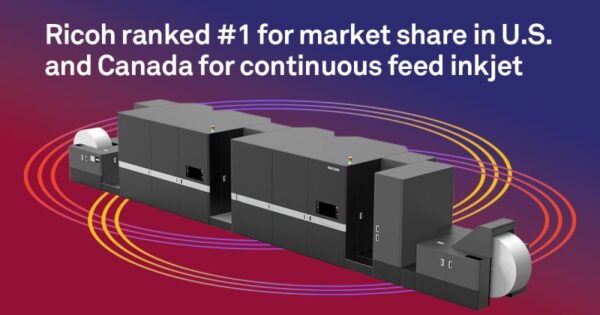A disruptive new product requires a radically creative launch strategy.
Hear that sound? That’s the sound of excitement slowly building around the Ricoh Pro Z75 sheet-fed inkjet press. For the past few months, Ricoh has been teasing users and dealers with bits of information about this new production device even though an official launch date has yet to be announced.
Teasing a product in this fashion is unusual for Ricoh. The reason, according to Heather Poulin, vice president, commercial & industrial printing marketing and portfolio management, Ricoh USA, is because the company views the Z75 as a disruptor for the commercial print industry.

Above: Gavin Jordan-Smith
“We need to build a pipeline of opportunity and we need to include working with our dealer partners to do that,” added Gavin Jordan-Smith, senior vice president, RICOH Graphic Communications. “Ricoh has been a leader in the continuous feed inkjet space and wide-format inkjet space for a number of years. We’re coming out with a B2 platform and spent a lot of time getting it right, which is why we’re making sure we’re teasing the market with innovative technology, fostering pent up demand, creating the right thought leadership around it, and introducing a press at the center of digital transformation in the printing industry.”
Ricoh is targeting commercial printers, CRDs, and resellers with this campaign. Teaser campaigns on social media have been gradually unveiling different aspects of the new RICOH Pro Z75. In addition, Ricoh has unveiled a new ecosystem at futuredefiningtechnology.com to help build community and advocacy, not only around the Pro Z75, but around inkjet as a whole.

Above: Heather Poulin
“We chose a dragon to represent the Z75 because we wanted to create a unique image that would be fun, that would resonate with people and that they’d want to interact with, but was also tied to our roots,” explained Poulin. “Our founding principles are what drives us and what makes doing business with Ricoh different and gives our customers a good view of the type of company that Ricoh is. In Japanese mythology, the dragon symbolizes balance, freedom, wisdom, and good fortune. Those are all the things we want associated with the Ricoh Z75.”
The ultimate goal is to create, on a global scale, a close-knit community of customers and prospects not only around the Z75, but around inkjet and Ricoh. “We wanted it to be engaging and wanted it to provide useful information not only around the Z75 but inkjet in general, especially as we see the industry trends moving from offset to digital,” said Poulin.
The Ricoh Z75 is described by Ricoh as the first B2 automatic perfecting sheet-fed inkjet press running aqueous inks. It was developed, according to Ricoh, to reflect the changing commercial print landscape. The focus is on short runs and accelerating the transition from offset to digital in the commercial print segment—a segment still largely analog.
The Z75 was built from the ground up and offers the advantages of digital toner production printing at the low running cost and high productivity of inkjet, according to Ricoh. It also offers consistency on uncoated, inkjet treated and offset coated stocks; broad sheet size support (ranging from A3 up to B2 and media weights from 60–400 gsm); a competitive price and low operational cost; “stunning” image quality and maximum productivity of 4500 sph (4/0); optimization of short runs and variable data jobs; and scalability for growth.
According to Jordan-Smith, the Z75 is positioned between Ricoh’s high-end sheet-fed production devices and its continuous feed inkjet devices.
“It’s a perfect solution for commercial printers who want to migrate shorter run offset jobs to digital,” he said. “It’s a good device for backup on the continuous-feed products and it’s the next step up for those customers who have sheet-fed production devices but are looking for that next higher level for a little bit longer runs.”
Jordan-Smith noted that applications will drive print volume in the digital space and a B2 press like this accommodates other applications that perhaps Ricoh’s A3 or B3 platforms can’t.
“Based on the applications from packaging to commercial print to transaction and direct mail, this opens up another area of adjacent markets that we can get into on our digital platform,” he said.
Highlight Reel
These are the highlights and benefits of the Ricoh Pro Z75, courtesy of Ricoh:
· Print speeds of 4500sph (4/0) and automatic duplex print speed of 2250sph (4/4).
· Ability to run a mix of uncoated 60-400gsm and offset coated 73-400gsm to support the migration of short-run jobs to digital.
· B2 plus media size 23 inches x 29 inches enables the imposition of more images in a sheet.
· A new scalable digital front end developed in conjunction with EFI connects to different workflows, broadening the range and complexity of jobs without having to redesign workflows.
· New optimized Ricoh developed printhead technology supports 1200×1200 dpi resolution at all speeds.
· New aqueous inks achieve a higher gamut to match offset.
· A new dryer system that delivers excellent quality on thin paper without cockling.
· A new paper transportation technology combining a variety of Ricoh developments helps ensure accuracy on a diverse range of formats from B2 plus to A3. This reduces waste.
· Accurate front to back registration using real-time correction drives greater consistency.
· A maximum duty cycle: 2.6M B2+ impressions/month.
· APV range: 250K – 1.25M B2+ impressions/month.
· Heavy duty build quality (like offset presses).
· Cast iron and steel mainframe.
Access Related Content
To become a subscriber, visit www.thecannatareport.com/register or contact cjcannata@cannatareport.com directly. Bulk subscription rates are also available.




